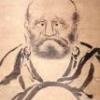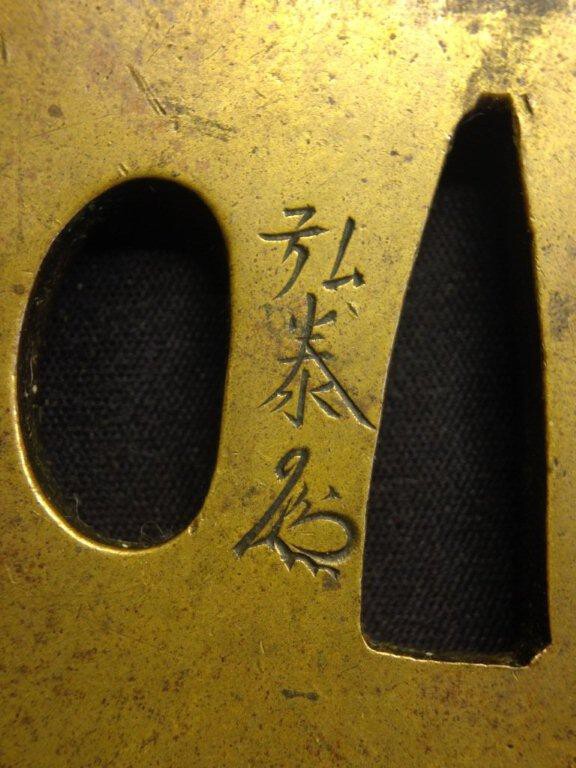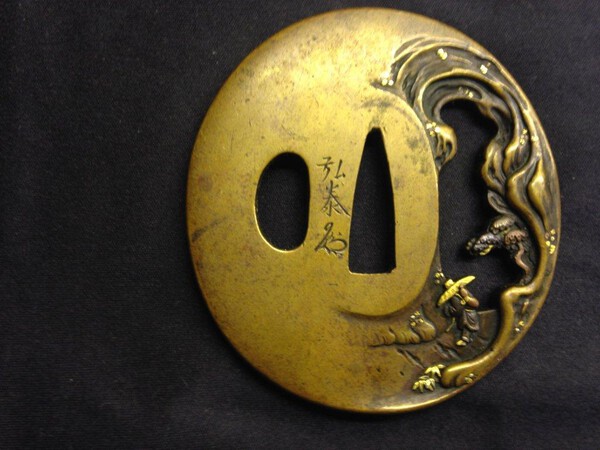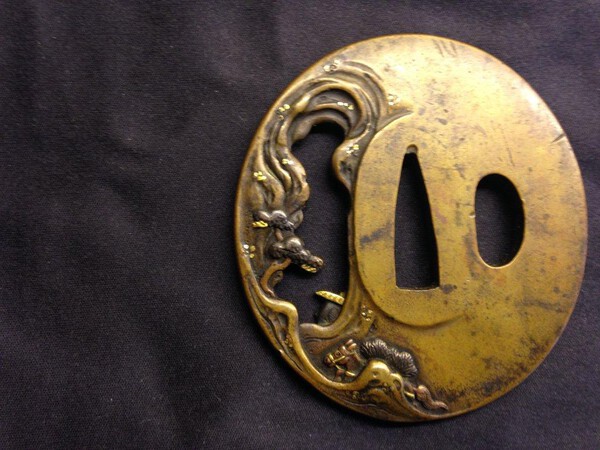-
Posts
2,356 -
Joined
-
Last visited
-
Days Won
11
Content Type
Profiles
Forums
Events
Store
Downloads
Gallery
Everything posted by Shugyosha
-

Looking For Some Help With My Newest Sword
Shugyosha replied to John Miller's topic in Military Swords of Japan
Thanks Jean. John, Rather than buy a book to cover this period, I think you would be better off trying to narrow down the smith to a particular province first of all. I've had a look through Hawley's Japanese Sword Smiths and there is a Katsumitsu working in Kaga between 1573 - 1596 and signing nijimei who looks like being the best candidate for the maker of your sword. The reference number is KAT119 and Hawley's notes say that he worked in the late Bizen style, was the first generation and Hawley gave him 15 points. He is also referenced in Fujishiro's Nihon Toko Jiten - I may have examples of his signature in my reference books but I don't have a working scanner at the moment - I'll have a go at taking some pictures of the relevant pages and see what they come out like. There are a number of other smiths signing Katsumitsu in Hawley's but this guy is the only one working in a period that covers the date on your sword. Best, John -

Looking For Some Help With My Newest Sword
Shugyosha replied to John Miller's topic in Military Swords of Japan
Hi John, Assuming the signature is legit, it's not a gunto but a traditional blade in army mounts. The signature is 勝光 - katsumitsu and the date is 天正十 四 年二月日 a day in February in the 14th year of Tensho (February 1587). Hope that helps, John -
Another one here: http://www.sanmei.com/contents/media/O102148_S827_PUP_E.html
-
The one at Nihonto.com is obvious enough for me to call Yamato, but would have probably guessed at Hosho had I not seen the attribution. The sword at Aoi art doesn't (to my uneducated eye) have sufficiently obvious Yamato traits for me to even call the province - far too subtle for me. Best, John
-
Also on Alan Bale's website number 1613: http://www.japaneseswordbooks.com/Tsuba.html
-
Hi Steve, I read a post recently where someone had engaged the services of Paul Martin for a guided tour of Tokyo sword shops. I thought I might do something similar if I'm ever in the position of being able to go. Here's his website: http://www.thejapanesesword.com/# Best regards, John
-
Hi Thomas, It's hard to tell as the picture doesn't enlarge when opened up. I think I can see "katana" and "mu mei" but the rest is too tiny. Best, John
-
I've paid more for worse swords than that. Shame about the nakago but on the evidence of those photographs, worth $500...
-
Hi Steve, You could try having a play with the lighting to see if you can get any better pictures of the hamon, hada and kissaki - I can't tell a lot from those pictures other than there appears to be a hamon. You might want to point the blade towards a spot light (fluorescent if possible) and let the light play down the hamon and hada to see if you can get a picture of any activity. As regards your earlier comments, I wouldn't expect to see the dragon chasing the pearl motif in the hamon of a koto blade and if it isn't significant in size it might just be nijuba that you are seeing. That wouldn't be out of keeping with koto Yamato or Yamashiro blades - another possibility would be yubashiri or shirake utsuri but it's hard to tell from the picture and we might be getting ahead of ourselves here though...when I hear hooves I try to think of horses rather than zebras. Best, John P.S. You could try holding the sword by the bare nakago. If it feels uncomfortable in the hand this might be where the cutting edge was originally - logically that should stop two or three inches before the mekugi ana nearest the nakago jiri. That could give a clue as to the original blade length.
-
Hi Gwyn, This is a pretty one: http://www.nihonto.com/5.10.12.html If I hadn't sold the kids already... Best, John
-
Hi Steve, It looks to me like there is some koshi sori going on there which would have been more pronounced before the blade was shortened - so what Uwe said. Masame makes me think of Yamato or one of the related schools but I have a book on Mino to which suggests that they would often have masame in the shinogi ji. Apparently they were generally kobuse forged and this is the hada of the shingane showing - the kawagane being folded differently gives different hada in the hiraji. I think this is also a kantei point for Ishido school blades but I don't think that the blade is young enough for that... It looks like an interesting blade and I'm curious to hear what others have to say. Best, John
-
Hi Paul, Thanks for taking the time to post this. I'll take a stab: 1. Kanbun shinto 2. Muromachi 3. Nanbokucho 4. Kamakura Best, John
-
Hi Rick, Is this not the blade that Mariusz sold last week? if so, did you not ask him for his views on it before you bought it? Kind regards, John
-

Double Bohi Shin Gunto Tachi ? A Very Unusual Ww2 Sword
Shugyosha replied to Cuirassier's topic in Military Swords of Japan
Mark, Don't do anything with the nakago. It already looks like an attempt has been made to clean up the tang around the mei - it's best left well alone as the removal of patina will affect the sword's value. Also, if you think this blade is worth a polish, get it out to Japan - if it is going to be papered it has probably got to go there anyway. Have a look at Kunitaro san's polishing service advertised in the "for sale" section - the prices are reasonable and it's a fairly quick turn around. Best regards, John -

Reasons To Shorten Nakago?
Shugyosha replied to Schmoopy's topic in General Nihonto Related Discussion
One daimyo was in the fortunate position of having two Masamune dai to and had one shortened to make a a dai sho.... I guess it might also be done to make a sword fit a replacement koshirae if having one made specifically wasn't an option. -

Connoisseurs Guide To Japanese Swords
Shugyosha replied to SAS's topic in General Nihonto Related Discussion
Sounds like you got a bargain. It's $350 here... http://www.nihonto.com/11.26.14.html -

Advise On Sword Purchase?
Shugyosha replied to Swordlook's topic in General Nihonto Related Discussion
Well, it's a nice, suriage shinto or shinshinto blade but IMHO the papers and maybe the cutting test are dodgy. The cutting test looks more like kinpun mei than the kinzogan mei stated on the papers: it doesn't look like it has been cut with a chisel with inlay added and there is no loss of gold from in the mei which wouldn't be unusual. It's signed with the name of a genuine sword tester, but as stated above, no kao... According to my reading, the papers also say that the blade was made 文久頃 (around Bunkyuu which started 1861). The cutting test says that it was done in Bunsei 文政 starting in 1818. So unless I'm really off the mark (not unusual for the partially educated), the cutting test took place before the papers say the blade was made. So all in all it doesn't add up for me, but I'm learning so please tell me if I'm overlooking something. Best regards, John -

Advise On Sword Purchase?
Shugyosha replied to Swordlook's topic in General Nihonto Related Discussion
This might be my poor Japanese and I apologise in advance if I have it wrong, but is there a discrepancy between the date of manufacture as stated on the papers and that of the cutting test? -
Is this a wind-up?
-
Hi Tobias, You might be interested in this series of articles where Tsuruta san of Aoi Art undertakes the renovation of a badly out of polish sword. The third one includes the creation of a window to view the hataraki in the blade. http://www.aoijapan.com/info/page/2 Kind regards, John
-
Hi Steve, I think that the kuni is Hishu (肥州) rather than Kishu (紀州) so a choice of Higo or Hizen rather than Kii for the province of manufacture. Hawleys has some possible candidates working in Hizen during the Edo period, none in Higo: HIR 367: Signing Hizen Kuni Ju Nin Fujiwara Hirosada (1st Generation) working around 1615 HIR 368: Signing Hizen Kuni Ju Hirosada (2nd Generation, son of Kanehiro, good suguba) working around 1684 HIR 364: Signing Hizen Kuni Ju Hirosada (son of Hirosada, presumably the one above) working around 1716. The first generation gets 20 points and the others 15 so average skill level. My guess would be one of the later generations as the sword looks to have the kanbun sugata. Best, John
-
Dear All, Apologies if this is widely known, but the above collection is available to view on line and might be of interest to those researching their tsuba: http://jameelcentre.ashmolean.org/collection/7/10237/10338 Kind regards, John
-
Hi Bruno and Christian, Many thanks for your replies. I agree, the mei doesn't seem to match, but I've exhausted my reference material as far as comparisons are concerned. Christian - it's not exactly to my taste either: it's a bit too twee hence it's an easy candidate to move on as one of those examples that isn't in keeping with where I see the rest of my collection going. Thanks once more, John
-
Gentlemen, I am planning to offer this tsuba for sale on the Board but thought that I would throw it open for comment before I do, not least of all so that I don't misdescribe it. This is an oval sentoku tsuba 70mm x 65mm x 4mm signed Hiroyoshi with kao. Haynes (H 01449.0) has a Hiroyoshi working in Mito signing with these kanji but the kao does not match any of those listed with this entry in Haynes. This gentleman has work dated to 1841-1842. The theme is that of a man leading a donkey through a mountain landscape. There is a similar design here, but I haven't been able to tie it down precisely: https://www.scholarsresource.com/browse/artist/2142569414?page=5 Any comments on the quality of workmanship or the theme? Many thanks, John





